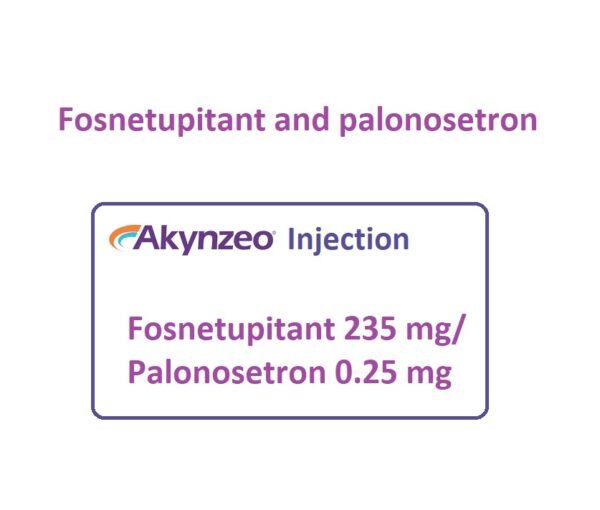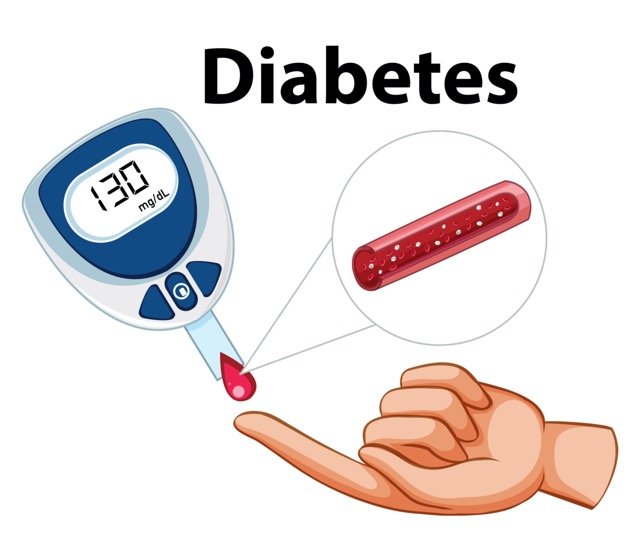Fosnetupitant and palonosetron (Akynzeo Injection) is a combination of two antiemetic drugs that is used in the treatment and prevention of chemotherapy-induced vomiting.
Fosnetupitant and palonosetron (Akynzeo Injection) Uses:
-
Chemotherapy-induced nausea and vomiting:
- Used in the treatment of acute and delayed nausea and vomiting associated with initial and repeat courses of highly emetogenic chemotherapy (in combination with dexamethasone).
- Limitations of use:
- It is not recommended for the prevention of vomiting and nausea associated with anthracycline plus cyclophosphamide (AC) chemotherapy.
Fosnetupitant and palonosetron (Akynzeo injection) Dose in Adults
Fosnetupitant and palonosetron (Akynzeo injection) Dose in patients on highly emetogenic chemotherapy (including cisplatin-based):
- IV:
- 235 mg Fosnetupitant and palonosetron 0.25 mg half an hour before chemotherapy on 1 day.
- Note: Antiemetic regimen also includes dexamethasone 12 mg monitored 30 minutes before chemotherapy on 1 day, and 8 mg one time in a day on days 2 to 4.
Use in Children:
Not indicated.
Pregnancy Risk Category: N (Some experts recommend avoiding it in pregnancy)
- Adverse events were observed in some animal reproduction studies that used the components of the combination product.
Use of fosnetupitant or palonosetron during breastfeeding
- When deciding whether to resume or start breastfeeding during therapy, it is important to consider the risks of infant exposure, the benefits to the mother and the benefits to the mother.
- It is not known if fosnetupitant and palonosetron are in breast milk.
Dose in Kidney Disease:
-
CrCl ≥30 mL/minute:
- No dosage adjustment is required.
-
CrCl <30 mL/minute:
- Restricted to use.
-
ESRD:
- Restricted to use(has not been studied).
Akynzeo Injection Dose in Liver disease:
-
Mild or moderate impairment (Child-Pugh classes A and B):
- No dosage adjustment is required.
-
Severe impairment (Child-Pugh class C):
- Restricted to use.
Contraindications to Fosnetupitant and palonosetron (Akynzeo injection):
Contradictions in the labeling of the manufacturer have not been included
Warnings and precautions
-
Hypersensitivity
- It has been reported using palonosetron (a component in the product), and with or without known hypersensitivity towards other 5HT-3 antagonists.
-
Serotonin syndrome:
- It has been reported when 5-HT3 receptor antagonists are used in combination with other serotonergic agent (eg, SNRIs and fentanyls, SSRIs or lithium), but it is most common when they are combined with other serotonergic drugs (eg, SNRIs. fentanyl. SSRIs. methylene blue. MAOIs. mirtazapine ).
- Some cases were extremely risky.
- Serotonin syndrome symptoms should be monitored by your doctor.
- Mental status changes (eg hallucinations and delirium, comas, agitation, etc.)
- autonomic instability: flushing, tachycardia and labile blood pressure, diaphoresis (dizziness, hyperthermia),
- neuromuscular changes (eg, hyperreflexia, incoordination, tremor, rigidity, myoclonus);
- Symptoms of gastrointestinal problems (eg, nausea, vomiting)
- seizures.
- Serotonin syndrome can be treated with supportive management.
- Most reports of serotonin syndrome with 5-HT3 receptor antagonists were made in a post-anesthesia setting, or in an infusion centre.
- Serotonin syndrome can also be caused by an overdose on another 5-HT3 receptor antagonist.
-
Hepatic impairment
- Use restricted in severe hepatic impairment Dosage adjustments are not required for mild or moderate impairment.
-
Renal impairment
- Do not use if you have severe renal impairment (SRI) or end-stage kidney disease (ESRD). Do not adjust dosage for mild or moderate impairment.
Fosnetupitant and palonosetron: Drug Interaction
|
Risk Factor C (Monitor therapy) |
|
|
Abemaciclib |
CYP3A4 Inhibitors (Moderate) may increase the serum concentration of Abemaciclib. |
|
AmLODIPine |
CYP3A4 Inhibitors (Moderate) may increase the serum concentration of AmLODIPine. |
|
Apixaban |
CYP3A4 Inhibitors (Moderate) may increase the serum concentration of Apixaban. |
|
ARIPiprazole: |
CYP3A4 Inhibitors (Moderate) may increase the serum concentration of ARIPiprazole. Management: Monitor for increased aripiprazole pharmacologic effects. Aripiprazole dose adjustments may or may not be required based on concomitant therapy and/or indication. Consult full interaction monograph for specific recommendations. |
|
Benzhydrocodone |
CYP3A4 Inhibitors (Moderate) may increase the serum concentration of Benzhydrocodone. Specifically, the concentration of hydrocodone may be increased. |
|
Blonanserin |
CYP3A4 Inhibitors (Moderate) may increase the serum concentration of Blonanserin. |
|
Bosentan |
May decrease the serum concentration of CYP3A4 Substrates (High risk with Inducers). |
|
Bosentan |
CYP3A4 Inhibitors (Moderate) may increase the serum concentration of Bosentan. Management: Concomitant use of both a CYP2C9 inhibitor and a CYP3A inhibitor or a single agent that inhibits both enzymes with bosentan is likely to cause a large increase in serum concentrations of bosentan and is not recommended. See monograph for details. |
|
Brexpiprazole |
CYP3A4 Inhibitors (Moderate) may increase the serum concentration of Brexpiprazole. Management: The brexpiprazole dose should be reduced to 25% of usual if used together with both a moderate CYP3A4 inhibitor and a strong or moderate CYP2D6 inhibitor, or if a moderate CYP3A4 inhibitor is used in a CYP2D6 poor metabolizer. |
|
Cannabidiol |
CYP3A4 Inhibitors (Moderate) may increase the serum concentration of Cannabidiol. |
|
Cannabis |
CYP3A4 Inhibitors (Moderate) may increase the serum concentration of Cannabis. More specifically, tetrahydrocannabinol and cannabidiol serum concentrations may be increased. |
|
Codeine |
CYP3A4 Inhibitors (Moderate) may decrease serum concentrations of the active metabolite(s) of Codeine. |
|
CYP3A4 Inducers (Moderate) |
May decrease the serum concentration of CYP3A4 Substrates (High risk with Inducers). |
|
CYP3A4 Substrates (High risk with Inhibitors) |
Fosnetupitant may increase the serum concentration of CYP3A4 Substrates (High risk with Inhibitors). |
|
Deferasirox |
May decrease the serum concentration of CYP3A4 Substrates (High risk with Inducers). |
|
Dofetilide |
CYP3A4 Inhibitors (Moderate) may increase the serum concentration of Dofetilide. |
|
Dronabinol |
CYP3A4 Inhibitors (Moderate) may increase the serum concentration of Dronabinol. |
|
Erdafitinib |
May decrease the serum concentration of CYP3A4 Substrates (High risk with Inducers). |
|
Estrogen Derivatives |
CYP3A4 Inhibitors (Moderate) may increase the serum concentration of Estrogen Derivatives. |
|
Halofantrine |
CYP3A4 Inhibitors (Moderate) may increase the serum concentration of Halofantrine. Management: Extreme caution, with possibly increased monitoring of ECGs, should be used if halofantrine is combined with moderate CYP3A4 inhibitors. Drugs listed as exceptions to this monograph are discussed in separate drug interaction monographs. |
|
HYDROcodone |
CYP3A4 Inhibitors (Moderate) may increase the serum concentration of HYDROcodone. |
|
Ifosfamide |
CYP3A4 Inhibitors (Moderate) may decrease serum concentrations of the active metabolite(s) of Ifosfamide. |
|
Imatinib |
CYP3A4 Inhibitors (Moderate) may increase the serum concentration of Imatinib. |
|
Manidipine |
CYP3A4 Inhibitors (Moderate) may increase the serum concentration of Manidipine. |
|
Mirodenafil |
CYP3A4 Inhibitors (Moderate) may increase the serum concentration of Mirodenafil. |
|
Naldemedine |
CYP3A4 Inhibitors (Moderate) may increase the serum concentration of Naldemedine. |
|
Nalfurafine |
CYP3A4 Inhibitors (Moderate) may increase the serum concentration of Nalfurafine. |
|
NiMODipine |
CYP3A4 Inhibitors (Moderate) may increase the serum concentration of NiMODipine. |
|
OxyCODONE |
CYP3A4 Inhibitors (Moderate) may enhance the adverse/toxic effect of OxyCODONE. CYP3A4 Inhibitors (Moderate) may increase the serum concentration of OxyCODONE. Serum concentrations of the active metabolite Oxymorphone may also be increased. |
|
Pimecrolimus |
CYP3A4 Inhibitors (Moderate) may decrease the metabolism of Pimecrolimus. |
|
Propafenone |
CYP3A4 Inhibitors (Moderate) may increase the serum concentration of Propafenone. Management: Drugs listed as exceptions to this monograph are discussed in further detail in separate drug interaction monographs. |
|
Rupatadine |
CYP3A4 Inhibitors (Moderate) may increase the serum concentration of Rupatadine. |
|
Ruxolitinib |
CYP3A4 Inhibitors (Moderate) may increase the serum concentration of Ruxolitinib. |
|
Salmeterol |
CYP3A4 Inhibitors (Moderate) may increase the serum concentration of Salmeterol. |
|
Sarilumab |
May decrease the serum concentration of CYP3A4 Substrates (High risk with Inducers). |
|
SAXagliptin |
CYP3A4 Inhibitors (Moderate) may increase the serum concentration of SAXagliptin. |
|
Serotonin Modulators |
Antiemetics (5HT3 Antagonists) may enhance the serotonergic effect of Serotonin Modulators. This could result in serotonin syndrome. Exceptions: Nicergoline. |
|
Sildenafil |
CYP3A4 Inhibitors (Moderate) may increase the serum concentration of Sildenafil. |
|
Silodosin |
CYP3A4 Inhibitors (Moderate) may increase the serum concentration of Silodosin. |
|
Siltuximab |
May decrease the serum concentration of CYP3A4 Substrates (High risk with Inducers). |
|
Tamsulosin |
CYP3A4 Inhibitors (Moderate) may increase the serum concentration of Tamsulosin. |
|
Tapentadol |
Antiemetics (5HT3 Antagonists) may diminish the analgesic effect of Tapentadol. |
|
Telithromycin |
CYP3A4 Inhibitors (Moderate) may increase the serum concentration of Telithromycin. |
|
Tetrahydrocannabinol |
CYP3A4 Inhibitors (Moderate) may increase the serum concentration of Tetrahydrocannabinol. |
|
Ticagrelor |
CYP3A4 Inhibitors (Moderate) may increase the serum concentration of Ticagrelor. |
|
Tocilizumab |
May decrease the serum concentration of CYP3A4 Substrates (High risk with Inducers). |
|
Trabectedin |
CYP3A4 Inhibitors (Moderate) may increase the serum concentration of Trabectedin. |
|
TraMADol |
Antiemetics (5HT3 Antagonists) may diminish the analgesic effect of TraMADol. |
|
Udenafil |
CYP3A4 Inhibitors (Moderate) may increase the serum concentration of Udenafil. |
|
Vilazodone |
CYP3A4 Inhibitors (Moderate) may increase the serum concentration of Vilazodone. |
|
Vindesine |
CYP3A4 Inhibitors (Moderate) may increase the serum concentration of Vindesine. |
|
Zuclopenthixol |
CYP3A4 Inhibitors (Moderate) may increase the serum concentration of Zuclopenthixol. |
|
Risk Factor D (Consider therapy modification) |
|
|
Acalabrutinib |
CYP3A4 Inhibitors (Moderate) may increase the serum concentration of Acalabrutinib. Management: Reduce acalabrutinib dose to 100 mg once daily with concurrent use of a moderate CYP3A4 inhibitor. Monitor patient closely for both acalabrutinib response and evidence of adverse effects with any concurrent use. |
|
Avanafil |
CYP3A4 Inhibitors (Moderate) may increase the serum concentration of Avanafil. Management: The maximum avanafil adult dose is 50 mg per 24-hour period when used together with a moderate CYP3A4 inhibitor. Patients receiving such a combination should also be monitored more closely for evidence of adverse effects. |
|
Brigatinib |
CYP3A4 Inhibitors (Moderate) may increase the serum concentration of Brigatinib. Management: Avoid concurrent use of brigatinib with moderate CYP3A4 inhibitors when possible. If such a combination cannot be avoided, reduce the dose of brigatinib by approximately 40% (ie, from 180 mg to 120 mg, from 120 mg to 90 mg, or from 90 mg to 60 mg). |
|
Bromocriptine |
CYP3A4 Inhibitors (Moderate) may increase the serum concentration of Bromocriptine. Management: The bromocriptine dose should not exceed 1.6 mg daily with use of a moderate CYP3A4 inhibitor. The Cycloset brand specifically recommends this dose limitation, but other bromocriptine products do not make such specific recommendations. |
|
Budesonide (Topical) |
CYP3A4 Inhibitors (Moderate) may increase the serum concentration of Budesonide (Topical). Management: Per US prescribing information, avoid this combination. Canadian product labeling does not recommend strict avoidance. If combined, monitor for excessive glucocorticoid effects as budesonide exposure may be increased. |
|
Cilostazol |
CYP3A4 Inhibitors (Moderate) may increase the serum concentration of Cilostazol. Management: Consider reducing the cilostazol dose to 50 mg twice daily in adult patients who are also receiving moderate inhibitors of CYP3A4. |
|
Colchicine |
CYP3A4 Inhibitors (Moderate) may increase the serum concentration of Colchicine. Management: Reduce colchicine dose as directed when using with a moderate CYP3A4 inhibitor, and increase monitoring for colchicine-related toxicity. See full monograph for details. Use extra caution in patients with impaired renal and/or hepatic function. |
|
Dabrafenib |
May decrease the serum concentration of CYP3A4 Substrates (High risk with Inducers). Management: Seek alternatives to the CYP3A4 substrate when possible. If concomitant therapy cannot be avoided, monitor clinical effects of the substrate closely (particularly therapeutic effects). |
|
Dapoxetine |
CYP3A4 Inhibitors (Moderate) may increase the serum concentration of Dapoxetine. Management: The dose of dapoxetine should be limited to 30 mg per day when used together with a moderate inhibitor of CYP3A4. |
|
Deflazacort |
CYP3A4 Inhibitors (Moderate) may increase serum concentrations of the active metabolite(s) of Deflazacort. Management: Administer one third of the recommended deflazacort dose when used together with a strong or moderate CYP3A4 inhibitor. |
|
Dexamethasone (Systemic) |
Fosnetupitant may increase the serum concentration of Dexamethasone (Systemic). Management: Decrease dexamethasone doses to 12 mg on day 1, and if needed based on the emetic potential of the regimen, 8 mg daily on days 2 to 4 of chemotherapy when administered with fosnetupitant. |
|
DOXOrubicin (Conventional) |
CYP3A4 Inhibitors (Moderate) may increase the serum concentration of DOXOrubicin (Conventional). Management: Seek alternatives to moderate CYP3A4 inhibitors in patients treated with doxorubicin whenever possible. One U.S. manufacturer (Pfizer Inc.) recommends that these combinations be avoided. |
|
Eletriptan |
CYP3A4 Inhibitors (Moderate) may increase the serum concentration of Eletriptan. Management: The use of eletriptan within 72 hours of a moderate CYP3A4 inhibitor should be avoided. |
|
Eliglustat |
CYP3A4 Inhibitors (Moderate) may increase the serum concentration of Eliglustat. Management: Use should be avoided under some circumstances. See full drug interaction monograph for details. |
|
Encorafenib |
CYP3A4 Inhibitors (Moderate) may increase the serum concentration of Encorafenib. Management: Avoid concomitant use of encorafenib and moderate CYP3A4 inhibitors whenever possible. If concomitant administration is unavoidable, decrease the encorafenib dose to one-half of the encorafenib dose used prior to initiation of the CYP3A4 inhibitor. |
|
Eplerenone |
CYP3A4 Inhibitors (Moderate) may increase the serum concentration of Eplerenone. Management: When used concomitantly with moderate inhibitors of CYP3A4, eplerenone dosing recommendations vary by indication and international labeling. See full drug interaction monograph for details. |
|
Everolimus |
CYP3A4 Inhibitors (Moderate) may increase the serum concentration of Everolimus. Management: Everolimus dose reductions are required for most indications. See full monograph or prescribing information for specific dose adjustment and monitoring recommendations. |
|
FentaNYL |
CYP3A4 Inhibitors (Moderate) may increase the serum concentration of FentaNYL. Management: Monitor patients closely for several days following initiation of this combination, and adjust fentanyl dose as necessary. |
|
GuanFACINE |
CYP3A4 Inhibitors (Moderate) may increase the serum concentration of GuanFACINE. Management: Reduce the guanfacine dose by 50% when initiating this combination. |
|
Ibrutinib |
CYP3A4 Inhibitors (Moderate) may increase the serum concentration of Ibrutinib. Management: When treating B-cell malignancies, decrease ibrutinib to 280 mg daily when combined with moderate CYP3A4 inhibitors. When treating graft versus host disease, monitor patients closely and reduce the ibrutinib dose as needed based on adverse reactions. |
|
Ivacaftor |
CYP3A4 Inhibitors (Moderate) may increase the serum concentration of Ivacaftor. Management: Ivacaftor dose reductions are required; consult full monograph content for specific age- and weight-based recommendations. No dose adjustment is needed when using ivacaftor/lumacaftor with a moderate CYP3A4 inhibitor. |
|
Ivosidenib |
CYP3A4 Inhibitors (Moderate) may increase the serum concentration of Ivosidenib. Management: Avoid use of moderate CYP3A4 inhibitors with ivosidenib whenever possible. If combined, monitor for increased ivosidenib toxicities. Drugs listed as exceptions are discussed in further detail in separate drug interaction monographs. |
|
Lorlatinib |
May decrease the serum concentration of CYP3A4 Substrates (High risk with Inducers). Management: Avoid concurrent use of lorlatinib with any CYP3A4 substrates for which a minimal decrease in serum concentrations of the CYP3A4 substrate could lead to therapeutic failure and serious clinical consequences. |
|
Lurasidone |
CYP3A4 Inhibitors (Moderate) may increase the serum concentration of Lurasidone. Management: Lurasidone US labeling recommends reducing lurasidone dose by half with a moderate CYP3A4 inhibitor. Some non-US labeling recommends initiating lurasidone at 20 mg/day and limiting dose to 40 mg/day; avoid concurrent use of grapefruit products. |
|
Olaparib |
CYP3A4 Inhibitors (Moderate) may increase the serum concentration of Olaparib. Management: Avoid use of moderate CYP3A4 inhibitors in patients being treated with olaparib, if possible. If such concurrent use cannot be avoided, the dose of olaparib should be reduced to 150 mg twice daily. |
|
Pitolisant |
May decrease the serum concentration of CYP3A4 Substrates (High risk with Inducers). Management: Combined use of pitolisant with a CYP3A4 substrate that has a narrow therapeutic index should be avoided. Other CYP3A4 substrates should be monitored more closely when used with pitolisant. |
|
Ranolazine |
CYP3A4 Inhibitors (Moderate) may increase the serum concentration of Ranolazine. Management: Limit the ranolazine adult dose to a maximum of 500 mg twice daily in patients concurrently receiving moderate CYP3A4 inhibitors (e.g., diltiazem, verapamil, erythromycin, etc.). |
|
Sirolimus |
CYP3A4 Inhibitors (Moderate) may increase the serum concentration of Sirolimus. Management: Monitor for increased serum concentrations of sirolimus if combined with a moderate CYP3A4 inhibitor. Lower initial sirolimus doses or sirolimus dose reductions will likely be required. |
|
Sonidegib |
CYP3A4 Inhibitors (Moderate) may increase the serum concentration of Sonidegib. Management: Avoid concomitant use of sonidegib and moderate CYP3A4 inhibitors when possible. When concomitant use cannot be avoided, limit CYP3A4 inhibitor use to less than 14 days and monitor for sonidegib toxicity (particularly musculoskeletal adverse reactions). |
|
St John's Wort |
May decrease the serum concentration of CYP3A4 Substrates (High risk with Inducers). Management: Consider an alternative for one of the interacting drugs. Some combinations may be specifically contraindicated. Consult appropriate manufacturer labeling. |
|
Suvorexant |
CYP3A4 Inhibitors (Moderate) may increase the serum concentration of Suvorexant. Management: The recommended dose of suvorexant is 5 mg daily in patients receiving a moderate CYP3A4 inhibitor. The dose can be increased to 10 mg daily (maximum dose) if necessary for efficacy. |
|
Tezacaftor |
CYP3A4 Inhibitors (Moderate) may increase the serum concentration of Tezacaftor. Management: When combined with moderate CYP3A4 inhibitors, tezacaftor/ivacaftor (100 mg/150 mg) should be given in the morning, every other day. Ivacaftor (150 mg) alone should be given in the morning, every other day on alternate days from tezacaftor/ivacaftor. |
|
Tolvaptan |
CYP3A4 Inhibitors (Moderate) may increase the serum concentration of Tolvaptan. Management: Jynarque dose requires adjustment when used with a moderate CYP3A4 inhibitor. See labeling or full interaction monograph for specific recommendations. Use of Samsca with moderate CYP3A4 ihibitors should generally be avoided. |
|
Venetoclax |
CYP3A4 Inhibitors (Moderate) may increase the serum concentration of Venetoclax. Management: Reduce the venetoclax dose by at least 50% in patients requiring these combinations. |
|
Zopiclone |
CYP3A4 Inhibitors (Moderate) may increase the serum concentration of Zopiclone. Management: The starting adult dose of zopiclone should not exceed 3.75 mg if combined with a moderate CYP3A4 inhibitor. Monitor patients for signs and symptoms of zopiclone toxicity if these agents are combined. |
|
Risk Factor X (Avoid combination) |
|
|
Apomorphine |
Antiemetics (5HT3 Antagonists) may enhance the hypotensive effect of Apomorphine. |
|
Aprepitant |
CYP3A4 Inhibitors (Moderate) may increase the serum concentration of Aprepitant. |
|
Asunaprevir |
CYP3A4 Inhibitors (Moderate) may increase the serum concentration of Asunaprevir. |
|
Bosutinib |
CYP3A4 Inhibitors (Moderate) may increase the serum concentration of Bosutinib. |
|
Budesonide (Systemic) |
CYP3A4 Inhibitors (Moderate) may increase the serum concentration of Budesonide (Systemic). |
|
Cobimetinib |
CYP3A4 Inhibitors (Moderate) may increase the serum concentration of Cobimetinib. Management: Avoid the concomitant use of cobimetinib and moderate CYP3A4 inhibitors. If concurrent short term (14 days or less) use cannot be avoided, reduce the cobimetinib dose to 20 mg daily. |
|
CYP3A4 Inducers (Strong) |
May decrease serum concentrations of the active metabolite(s) of Fosnetupitant. |
|
Domperidone |
CYP3A4 Inhibitors (Moderate) may increase the serum concentration of Domperidone. Management: Drugs listed as exceptions to this monograph are discussed in further detail in separate drug interaction monographs. |
|
Flibanserin |
CYP3A4 Inhibitors (Moderate) may increase the serum concentration of Flibanserin. |
|
Fosaprepitant |
CYP3A4 Inhibitors (Moderate) may increase the serum concentration of Fosaprepitant. |
|
Ivabradine |
CYP3A4 Inhibitors (Moderate) may increase the serum concentration of Ivabradine. |
|
Lomitapide |
CYP3A4 Inhibitors (Moderate) may increase the serum concentration of Lomitapide. |
|
Naloxegol |
CYP3A4 Inhibitors (Moderate) may increase the serum concentration of Naloxegol. |
|
Neratinib |
CYP3A4 Inhibitors (Moderate) may increase the serum concentration of Neratinib. |
|
Pimozide |
CYP3A4 Inhibitors (Moderate) may increase the serum concentration of Pimozide. |
|
Simeprevir |
CYP3A4 Inhibitors (Moderate) may increase the serum concentration of Simeprevir. |
|
Ulipristal |
CYP3A4 Inhibitors (Moderate) may increase the serum concentration of Ulipristal. Management: This is specific for when ulipristal is being used for signs/symptoms of uterine fibroids (Canadian indication). When ulipristal is used as an emergency contraceptive, patients receiving this combination should be monitored for ulipristal toxicity. |
Monitoring parameters:
- signs and symptoms of hypersensitivity and serotonin syndrome are monitored.
How to administer Fosnetupitant and palonosetron (Akynzeo injection)?
IV:
- Flush infusion line (with the same solution as used for dilution) after consideration of palonosetron and fosnetupitant to ensure complete consideration.
- If the same IV line is used for sequential considerations of other medications, flush the line with NS before and after fosnetupitant and palonosetron consideration.
Mechanism of action of Fosnetupitant and palonosetron (Akynzeo injection):
- Fosnetupitant, a prodrug from netupitant and a selective substance P/neurokinin receptor antagonist (NK-1 receptor antagonist), augments the antiemetic activities of 5-HT3 receptor antagonists, corticosteroids, and corticosteroids to inhibit chemotherapy-induced emesis.
- Palonosetron, a selective 5-HT3 receptor antagonist blocks serotonin on both vagal nerve terminals in peripheral areas and centrally in chemoreceptor trigger zones.
- Palonosetron blocks the cross-talk between 5-HT3 receptors and NK-1 receptors.
- Combining palonosetron with netupitant can inhibit the substance P response in a more effective way than either agent.
Protein binding:
- Fosnetupitant: 92 percent to 95 percent
- Palonosetron: ~62 percent
Excretion:
- Fosnetupitant: Fosnetupitant is a prodrug of netupitant (plasma fosnetupitant concentrations rapidly decline shortly after infusion);
- Netupitant: Feces (~71 percent); urine (~4 percent);
- Palonosetron: Feces (5 percent to 8 percent); urine (85 percent to 93 percent; 40 percent as unchanged drug)
Metabolism:
- Fosnetupitant is a prodrug and is converted by hydrolysis to netupitant;
- Netupitant is metabolized extensively hepatic via CYP3A4 (major), CYP2C9 (minor), and CYP2D6 (minor);
- forms active metabolites M1, M2, and M3;
- Palonosetron: ~50 percent is metabolized to relatively inactive metabolites (N-oxide-palonosetron and 6-S-hydroxy-palonosetron);
- CYP2D6, 3A4, and 1A2 contribute to metabolism
Half-life elimination:
- Fosnetupitant: 0.75 ± 0.4 hours;
- Netupitant: 144 ± 73 hours;
- Palonosetron: 58 ± 27 hours
Time to peak:
- At end of the 30-minute infusion
International Brand Names of Fosnetupitant and palonosetron:
- Akynzeo
Fosnetupitant and palonosetron Brand Names in Pakistan:
There is no brand available in Pakistan.







